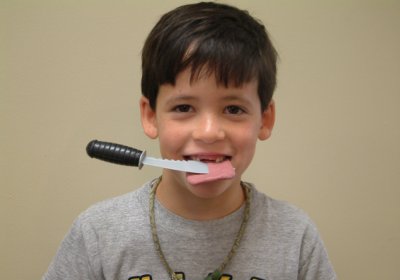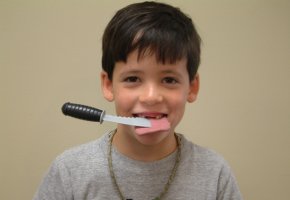FAQs - Child Orthodontics
The information below is an excellent resource related to orthodontic treatment of children. Click here for further information about what age is optimal to begin orthodontic treatment.
What is preventive orthodontic treatment?
 Orthodontist with Patient
Orthodontist with PatientPreventive orthodontic treatment is intended to keep a malocclusion (“bad bite” or crooked teeth) from developing in an otherwise normal mouth. The goal is to provide adequate space for permanent teeth to come in. Treatment may require a space maintainer to hold space for a primary (baby) tooth lost too early, or removal of primary teeth that do not come out on their own so to create room for permanent teeth.
What is interceptive orthodontic treatment?
Interceptive orthodontic treatment is performed for problems that, if left untreated, could lead to the development of more serious dental problems over time. The goal is to reduce the severity of a developing problem and eliminate the cause. The length of later comprehensive orthodontic treatment may be reduced. Examples of this kind of orthodontic treatment may include correction of thumb- and finger-sucking habits; guiding permanent teeth into desired positions through tooth removal or tooth size adjustment; or gaining or holding space for permanent teeth. Interceptive orthodontic treatment can take place when patients have primary teeth or mixed dentition (baby and permanent teeth). A patient may require more than one phase of interceptive orthodontic treatment.
What is comprehensive orthodontic treatment?
Comprehensive orthodontic treatment is undertaken for problems that involve alignment of the teeth, how the jaws function and how the top and bottom teeth fit together. The goal of comprehensive orthodontic treatment is to correct the identified problem and restore the occlusion (the bite) to its optimum. Treatment can begin while patients have primary teeth, when they have a mix of primary and permanent teeth, or when all permanent teeth are in. Treatment may consist of one or more phases, depending on the nature of the problem being corrected and the goals for treatment.
Orthodontic care may be coordinated with other types of dental treatment that may include oral surgery (tooth extractions or jaw surgery), periodontal (gum) care and restorative (fillings, crowns, bridges, tooth size enhancement, implants) dental care. When finished with comprehensive treatment, the patient must wear retainers to keep teeth in their new positions.
What is a space maintainer?
Baby molar teeth, also known as primary molar teeth, hold needed space for permanent teeth that will come in later. When a baby molar tooth is lost, an orthodontic device with a fixed wire is usually put between teeth to hold the space for the permanent tooth.
Why do baby teeth sometimes need to be removed?
Removing baby teeth may be necessary to allow severely crowded permanent teeth to come in at a normal time in a reasonably normal location. If the teeth are severely crowded, it may be that some unerupted permanent teeth (usually the canine teeth) will either remain impacted (teeth that should come in, but do not), or come in to a highly undesirable position. To allow severely crowded teeth to move on their own into much more desirable positions, sequential removal of baby teeth and permanent teeth (usually first premolars) can dramatically improve a severe crowding problem. This sequential extraction of teeth, called serial extraction, is typically followed by comprehensive orthodontic treatment after eruption of permanent teeth has brought about as much improvement as it can on its own.
After all the permanent teeth have come in, the extraction of selected permanent teeth may be necessary to correct crowding or to make space for necessary tooth movement to correct a bite problem. Proper extraction of teeth during orthodontic treatment should leave the patient with both excellent function and a pleasing look.
How can a child's growth affect orthodontic treatment?
Orthodontic treatment and a child’s growth can complement each other. A common orthodontic problem to treat is protrusion of the upper front teeth. Quite often this problem is due in part to the lower jaw being shorter than the upper jaw. Upper teeth may also be the primary cause of the protrusion if they stick out too far. While the upper and lower jaws are growing, orthodontic appliances can be beneficial in reducing these discrepancies. A severe jaw growth discrepancy may require orthodontics and corrective surgery after jaw growth has been completed, although this is rare.
The AAO recommends that all children have a check-up with an orthodontist no later than age 7 so that growth-related problems may be identified and so that treatment can be commenced at the appropriate time for each patient.
Can my child play sports while wearing braces?
Yes. But wearing a protective mouth guard is advised while riding a bike, skating, or playing any contact sports, whether organized sports or a neighborhood game. Your orthodontist can recommend a specific mouth guard.
Will braces interfere with playing musical instruments?
Playing wind or brass instruments, such as the trumpet, will clearly require some adaptation to braces. With practice and a period of adjustment, braces typically do not interfere with the playing of musical instruments.
Why does orthodontic treatment time sometimes last longer than anticipated?
Estimates of treatment time can only be that - estimates. Patients grow at different rates and will respond in their own ways to orthodontic treatment. The orthodontist has specific treatment goals in mind, and will usually continue treatment until these goals are achieved. Patient cooperation, however, is the single best predictor of staying on time with treatment. Patients who cooperate by wearing rubber bands or other needed appliances as directed, while taking care not to damage appliances, will most often lead to on-time and excellent treatment results.
What is patient cooperation and how important is it during orthodontic treatment?
Good “patient cooperation” means that the patient not only follows the orthodontist’s instructions on wearing appliances as prescribed and tending to oral hygiene and diet, but is also an active partner in orthodontic treatment.
Successful orthodontic treatment is a “two-way street” that requires a consistent, cooperative effort by both the orthodontist and patient. To successfully complete the treatment plan, the patient must carefully clean his or her teeth, wear rubber bands, headgear or other appliances as prescribed by the orthodontist, avoid foods that might damage braces and keep appointments as scheduled. Damaged appliances can lengthen the treatment time and may undesirably affect the outcome of treatment. The teeth and jaws can only move toward their desired positions if the patient consistently wears the forces to the teeth, such as rubber bands, as prescribed. Patients who do their part consistently make themselves look good and their orthodontist look smart.
To keep teeth and gums healthy, regular visits to the family dentist must continue during orthodontic treatment.
I recently took my child to an orthodontist for an orthodontic check-up. The orthodontist recommended treatment. Should I seek a second opinion?
You should review the recommended treatment with your family dentist. If you would like a second opinion, feel comfortable in arranging for one. You may have already had more than one orthodontist recommended to you by family, friends or your dentist. Seeking out a member of the AAO assures that your second opinion is from an educationally qualified orthodontic specialist. You should feel confident in the orthodontist and his or her staff, and trust their ability to provide you with the best possible care.
What is two-phase treatment?
Two-phase treatment simply means that the treatment is carried out in two stages. The first is the interceptive orthodontic phase (see above) and the second is the comprehensive orthodontic phase (see above).
Some of my children’s friends have already started treatment, but our orthodontist says my child should wait a while. Why is there a difference in treatment?
Each treatment plan is specific for that child and his/her specific problem. In some cases, children mature early (e.g.: get their permanent teeth early) and in some cases early treatment is indicated to prevent a more severe problem from occurring. Your orthodontist is the best person to decide the most optimum treatment plan. If you have questions, you should discuss them with your orthodontist.
What do the initials mean after an orthodontist’s name?
The initials after an orthodontist’s name indicate the academic education of the orthodontist. For instance, DMD and DDS indicate that the individual is a graduate dentist. M.S. or MSc indicates that the individual has achieved a Masters in Science degree, usually associated with orthodontic training.
My child has an allergy to nickel. Can my child still have orthodontic treatment?
Yes, there are appliances available which are nickel-free. Please tell your orthodontist if your child has any allergies.
How can I fit the orthodontist’s fee into my family budget?
Orthodontic costs and payment options can be discussed with your treating orthodontist. Your orthodontist will be able to provide you with information about insurance and other possible funding options.
Back to "FAQs - Main Page"





























